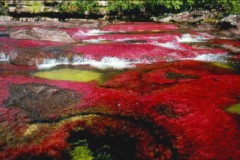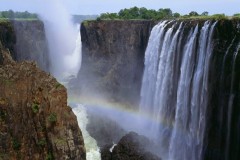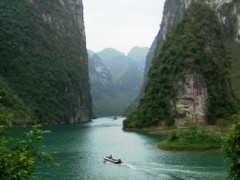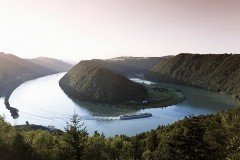Known as “the river that ran away from paradise,” the Caño Cristales in northern Colombia is often considered the most beautiful river in the world. Stunning, multi-hued algal streaks paint the riverbed in a kaleidoscopic palette of reds, yellows, blues, greens and blacks, while glassy waterfalls spill into neon-colored tide pools. The otherworldly rainbow effect emerges only during the height of summer when the heat helps resident algae colonies to grow and multiply, filling craters and eddies with intense bursts of color.
As beautiful as the Caño Cristales is, it’s only one in an array of beautiful rivers all around the world. We researched some of the world’s best, and along with travel sources such as Frommer’s and Fodor’s, came up with a list of ten rivers around that beg to be visited at least once in a lifetime.
Río Futaleufú, Chile and Argentina
The tiny, picturesque town of Futaleufú in Chile provides access to the river that bears its name, promising a waterway experience that rivals any in the world for its beauty and drama. Fed by a glacial runoff, the cold, clear blue waters of the river are a popular locale for heart-quickening tours by whitewater raft or kayak.
“It winds through lush forests and moody valleys from Argentina to Chile, providing all the beauty of the Andes and the Chilean and Argentine lakes districts of northern Patagonia,” says Kealy.

Cano Cristales River, Northern Colombia
Courtesy of English Cafe
Cano Cristales River, NorthernColombia
A psychedelic swirl of improbability, the Caño Cristales is sometimes called “the world’s most beautiful river,” and with good reason: It is the host to a dizzying array of colors that result from pockets of algae that bloom during the height of summer. Aquamarines push up against eddies of red and fingers of yellow cut through pockets of bright green in this river in Northern Colombia. At less than 100 kilometers long, and rarely more than 20 meters wide, this compact slice of river offers a kaleidoscope of otherworldly experiences – but it is not easy to get to: you’ll need to fly from Villavicencio to Macarena, then take a boat and cut through unmarked trails in order to find this jungle jewel of a river.

Courtesy of Getty Images
Zambezi River, Zambia andMozambique
The Zambezi flows 2,700 kilometers through six African countries before it spills into the Indian Ocean, allowing for a large array of ways to explore the riverside life and beauty of Africa. Although it is the fourth-largest river in Africa, it’s most popular spot by far is Victoria Falls, the world’s largest waterfalls, and one of the Seven Natural Wonders of the World.
Nearly a million people visit the falls every year to witness the awe-inspiring volume of water that cascades over 354 feet to the bottom at its deepest point, or to swim dizzyingly close to the edge at a naturally-safe swimming spot called “Devil’s Pool,” a popular location to take photoshopped-looking pictures of daredevil wading.

Yangtze River, China
Courtesy of Forbes Images
Yangtze River, China
The Yangtze is the longest river in Asia, providing a striking array of opportunities to explore Chinese life and the culture that sprouts along its banks. This is another river on which it pays to travel by boat cruise. Many of the cruises tend to be shorter than a week, but are guaranteed to provide access to some of the best rural Chinese experiences you can find..
“You see the Three Gorges Dam construction site, the gorgeous scenery and mountains, and the impressive pagodas along the river banks,” says Heidi Sarna, a Frommer’s contributor. “With all the changes going on, it will be a completely different place in ten years, so see it now.”

Danube River, Central Europe
Courtesy of Getty Images
Danube River, Central Europe
The Danube cuts and abuts ten nations in Central Europe, from the Black Forest in Germany down to the Black Sea in Romania. Along the way, it winds through medieval towns, towering castles, and historic sites that rival some of the world’s best river experiences. Take a riverboat cruise lasting anywhere from a few hours to two weeks to explore some of the best the river has to offer and take advantage of the daily excursions that allow you to dig deeper into the history and culture of one of Europe’s most important rivers.
Walang komento:
Mag-post ng isang Komento